成人高等教育学士学位英语考试复习要点
学位英语知识点复习资料

学位英语知识点复习资料
以下是学位英语的一些基本知识点复习资料:
1. 语法:复习英语的基本语法规则,包括时态、语态、句型、主谓一致等。
2. 词汇:复习常见的学术词汇,如学科名词、实验方法、研究领域等。
3. 阅读理解:提高阅读理解能力,包括快速阅读和理解主旨、细节、推理等。
多阅读
学术文章和论文,熟悉学术写作风格。
4. 写作技巧:学习学术写作的基本结构和格式,包括论文的引言、正文、结论等部分。
也要练习提高写作的逻辑性和清晰度。
5. 听力技巧:提高听力理解能力,包括听清主旨、关键词等,练习听写和记笔记。
6. 口语表达:提高口语交流能力,包括演讲、讨论、辩论等。
练习口语表达和流利性。
7. 学术资料查找和利用:学习使用学术数据库、图书馆资源等查找学术资料,提高筛
选和利用学术资料的能力。
8. 专业知识:了解自己专业领域的基本知识,熟悉相关的学术研究和发展动态。
这些是学位英语的一些基本知识点,希望对你的复习有所帮助。
此外,还建议你参考
相关教材和学习资源,进行系统的复习和练习。
学位英语知识点复习资料
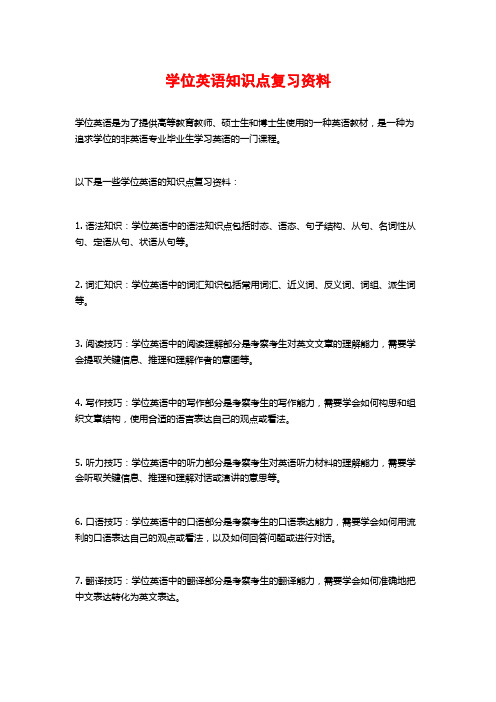
学位英语知识点复习资料
学位英语是为了提供高等教育教师、硕士生和博士生使用的一种英语教材,是一种为追求学位的非英语专业毕业生学习英语的一门课程。
以下是一些学位英语的知识点复习资料:
1. 语法知识:学位英语中的语法知识点包括时态、语态、句子结构、从句、名词性从句、定语从句、状语从句等。
2. 词汇知识:学位英语中的词汇知识包括常用词汇、近义词、反义词、词组、派生词等。
3. 阅读技巧:学位英语中的阅读理解部分是考察考生对英文文章的理解能力,需要学会提取关键信息、推理和理解作者的意图等。
4. 写作技巧:学位英语中的写作部分是考察考生的写作能力,需要学会如何构思和组织文章结构,使用合适的语言表达自己的观点或看法。
5. 听力技巧:学位英语中的听力部分是考察考生对英语听力材料的理解能力,需要学会听取关键信息、推理和理解对话或演讲的意思等。
6. 口语技巧:学位英语中的口语部分是考察考生的口语表达能力,需要学会如何用流利的口语表达自己的观点或看法,以及如何回答问题或进行对话。
7. 翻译技巧:学位英语中的翻译部分是考察考生的翻译能力,需要学会如何准确地把中文表达转化为英文表达。
以上是学位英语的一些常见知识点复习资料,希望对你有帮助。
成人本科学位英语复习资料

成人本科学位英语复习资料一、阅读理解1. 主旨大意题主旨大意题是一种常见的阅读理解题型。
在这种题目中,考生需要根据所给的文章内容,准确地理解文章的主旨和大意。
回答这类题目的关键是要抓住文章的中心思想,理解作者的观点和态度。
答题技巧: - 仔细阅读文章,找出文章的中心思想和重要细节。
- 注意文章的标题、首段和尾段,它们通常能够给出关键信息。
- 根据文章的语气和态度,判断作者的观点和立场。
2. 细节理解题细节理解题是一种考察对文章细节理解能力的题型。
在这类题目中,考生需要根据所给的文章内容,准确地理解文章中的细节信息,例如数字、时间、地点等。
答题技巧:- 仔细阅读文章,找出与问题相关的细节信息。
- 注意文章中数字、时间、地点等关键词,它们通常能够引导你找到正确答案。
- 注意词义的转换,有时候同义词或近义词可能会出现在文章中。
3. 推理判断题推理判断题是一种考察学生逻辑推理能力的题型。
在这类题目中,考生需要根据所给的文章内容,根据已有的信息进行推断。
答题技巧: - 仔细阅读文章,理解已有的信息。
- 根据已有的信息进行推理,并结合上下文进行判断。
- 注意排除干扰选项,选择最符合文章内容的答案。
二、翻译1. 英译汉英译汉是一种翻译题型,要求考生将给定的英文句子或短文翻译成汉语。
答题技巧: - 仔细理解英文句子或短文的意思。
- 注意复杂句的翻译,需准确传达句子的语义和语法结构。
- 注意上下文的语境,确保翻译的准确性和连贯性。
2. 汉译英汉译英是一种翻译题型,要求考生将给定的中文句子或短文翻译成英语。
答题技巧: - 仔细理解中文句子或短文的意思。
- 注意汉语表达与英语表达的差异,需准确传达句子的意思。
- 注意使用准确的词汇和语法结构,确保翻译的准确性和流畅性。
三、作文1. 议论文议论文是一种常见的作文题型,要求考生对某个问题或观点进行辩论和论述。
写作技巧: - 确定文章的结构,包括引言、主要论点、论据和结论等部分。
自考学士学位英语考试复习资料(语法词汇短词阅读作文)
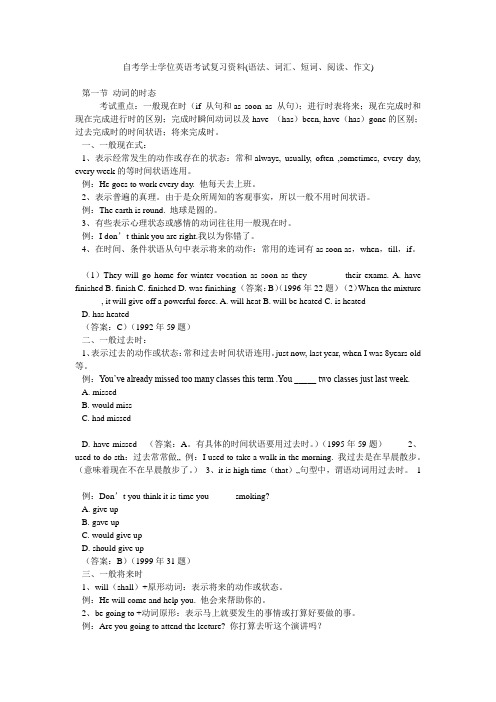
自考学士学位英语考试复习资料(语法、词汇、短词、阅读、作文)第一节动词的时态考试重点:一般现在时(if 从句和as soon as 从句);进行时表将来;现在完成时和现在完成进行时的区别;完成时瞬间动词以及have (has)been, have(has)gone的区别;过去完成时的时间状语;将来完成时。
一、一般现在式:1、表示经常发生的动作或存在的状态:常和always, usually, often ,sometimes, every day, every week的等时间状语连用。
例:He goes to work every day. 他每天去上班。
2、表示普遍的真理。
由于是众所周知的客观事实,所以一般不用时间状语。
例:The earth is round. 地球是圆的。
3、有些表示心理状态或感情的动词往往用一般现在时。
例:I don’t think you are right.我以为你错了。
4、在时间、条件状语从句中表示将来的动作:常用的连词有as soon as,when,till,if。
(1)They will go home for winter vocation as soon as they ________their exams. A. have finished B. finish C. finished D. was finishing (答案:B)(1996年22题)(2)When the mixture ______, it will give off a powerful force. A. will heat B. will be heated C. is heatedD. has heated(答案:C)(1992年59题)二、一般过去时:1、表示过去的动作或状态:常和过去时间状语连用。
just now, last year, when I was 8years old 等。
学位英语知识点复习资料
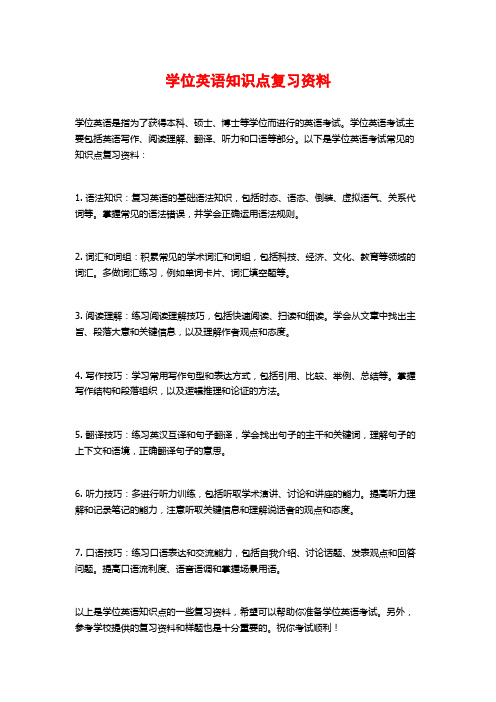
学位英语知识点复习资料
学位英语是指为了获得本科、硕士、博士等学位而进行的英语考试。
学位英语考试主要包括英语写作、阅读理解、翻译、听力和口语等部分。
以下是学位英语考试常见的知识点复习资料:
1. 语法知识:复习英语的基础语法知识,包括时态、语态、倒装、虚拟语气、关系代词等。
掌握常见的语法错误,并学会正确运用语法规则。
2. 词汇和词组:积累常见的学术词汇和词组,包括科技、经济、文化、教育等领域的词汇。
多做词汇练习,例如单词卡片、词汇填空题等。
3. 阅读理解:练习阅读理解技巧,包括快速阅读、扫读和细读。
学会从文章中找出主旨、段落大意和关键信息,以及理解作者观点和态度。
4. 写作技巧:学习常用写作句型和表达方式,包括引用、比较、举例、总结等。
掌握写作结构和段落组织,以及逻辑推理和论证的方法。
5. 翻译技巧:练习英汉互译和句子翻译,学会找出句子的主干和关键词,理解句子的上下文和语境,正确翻译句子的意思。
6. 听力技巧:多进行听力训练,包括听取学术演讲、讨论和讲座的能力。
提高听力理解和记录笔记的能力,注意听取关键信息和理解说话者的观点和态度。
7. 口语技巧:练习口语表达和交流能力,包括自我介绍、讨论话题、发表观点和回答问题。
提高口语流利度、语音语调和掌握场景用语。
以上是学位英语知识点的一些复习资料,希望可以帮助你准备学位英语考试。
另外,参考学校提供的复习资料和样题也是十分重要的。
祝你考试顺利!。
成人高等教育学士学位英语考试复习要点
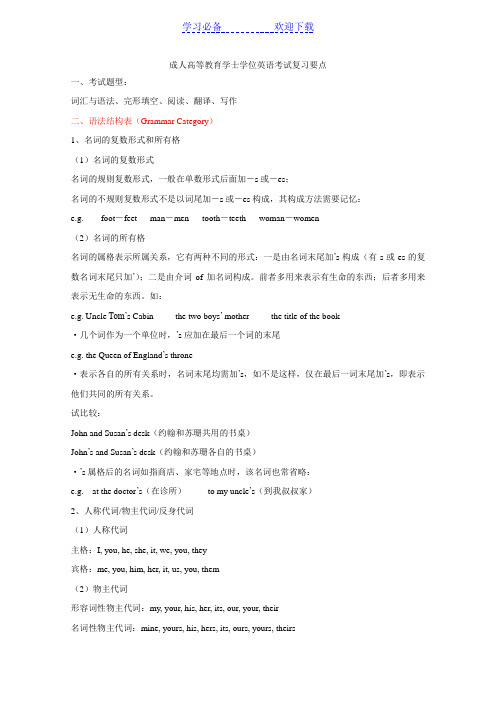
成人高等教育学士学位英语考试复习要点一、考试题型:词汇与语法、完形填空、阅读、翻译、写作二、语法结构表(Grammar Category)1、名词的复数形式和所有格(1)名词的复数形式名词的规则复数形式,一般在单数形式后面加-s或-es;名词的不规则复数形式不是以词尾加-s或-es构成,其构成方法需要记忆:e.g. foot-feet man-men tooth-teeth woman-women(2)名词的所有格名词的属格表示所属关系,它有两种不同的形式:一是由名词末尾加’s构成(有-s或-es的复数名词末尾只加’);二是由介词of加名词构成。
前者多用来表示有生命的东西;后者多用来表示无生命的东西。
如:e.g. Uncle Tom’s Cabin the two boys’ mother the title of the book·几个词作为一个单位时,’s应加在最后一个词的末尾e.g. the Queen of England’s throne·表示各自的所有关系时,名词末尾均需加’s,如不是这样,仅在最后一词末尾加’s,即表示他们共同的所有关系。
试比较:John and Susan’s desk(约翰和苏珊共用的书桌)John’s and Susan’s desk(约翰和苏珊各自的书桌)·’s属格后的名词如指商店、家宅等地点时,该名词也常省略:e.g. at the doctor’s(在诊所)to my uncle’s(到我叔叔家)2、人称代词/物主代词/反身代词(1)人称代词主格:I, you, he, she, it, we, you, they宾格:me, you, him, her, it, us, you, them(2)物主代词形容词性物主代词:my, your, his, her, its, our, your, their名词性物主代词:mine, yours, his, hers, its, ours, yours, theirs(3)反身代词(指一个动作回射到该动作执行者本身,表强调或加强语气)myself, yourself, himself, herself. Itself, ourselves; yourselves, themselves, oneselfe.g. Please help yourself to some tea.I want to speak to the director himself.3、句子和句子成分Sentence是具有主语部分和谓语部分并有完整意义的可以独立的一组词。
《成人学士学位英语》复习资料

《成人学士学位英语》复习资料《成人学士学位英语》复习资料主要以下面内容,结合课本复习。
注意:考试时一定要随身带大学英语5《综合练习习题与解答》一、考试复习范围(重点注意有下画线的内容) ((((((((((((1) 选择词汇范围:其中两个练习(p222 exercise one; p225 exercise two;p229 exercise three ;p233 exercisefour; p236 exercise five ;p240 exercise six)(2)阅读理解和翻译阅读理解范围:(p296 exercise six、p301 exercise Seven、以及大学英语5《综合练习习题与解答》中的阅读理解练习题第11、12。
)翻译范围:英译汉(上述六个阅读理解练习后的part II Sentence Translation) (3) 完型填空范围:两篇中选一篇(p350 exercise three; p351 exercise four; 以及大学英语5《综合练习习题与解答》中的完型填空练习题第4、5 。
)(4)作文重点注意P370 exercise Ten; p370 exercise Nine(注意exercise one ---exercise seventeen 都留意一下)二、复习重点讲解(1) 词汇练习一p2221(D avoid为“避免”,avoid doing something 避免做某事; 2. C diversion为:“转移”,a diversion of attention 转移注意力; 3(A identity 为:“辨别”。
4(C suggestion 为“建议”。
5(B derive something from something 从某物中剥夺某物; 6(D as far as I’m concerned 就我所知;7(A related to … 与…相关;8(D transfer something to something 把某物转移成某物; 9(B extend to… 扩展到…;10. D available… 存在的;11. B stage 展出;12(A access 路径;13(B worthwhile 值得的;14(D remind somebody of something 提醒某人某事;15(D considerate 体贴的;16(C bump my head against 把头撞到;17(A chance 机会;18(D previous 之前的,以前的;19(C be absorbed to do something 被吸引做某事;20(C be focused on something 被集中于某事;21(B all of a sudden 突然;22(A get about something 传播;流传; 23(D a narrow escape from death 狭窄的逃生路径;24(C now that 既然;25(B vigorous 充满活力的;26(B suppose 假设;27(D puzzle 难题;28(A mark 做记号;29(B get on with somebody 与某人相处; 30(B set about doing something 着手做某事; 31(B take somebody’s place 代替某人 32(A childish 幼稚的;33(C enjoy something from doing something 从做某事当中享受做某事;34(B favorite 最喜爱的;35(C violence 暴力;36(B hit somebody in the head 撞击某人头部; 37(A except 除了…之外;38(D resort to something 诉诸于某事; 39(C be neglected 被忽视;40(D survive 在…中生存;41(C catch sight of … 看到;42(B compliment 赞美,恭维; 43(B look into… 研究,调查; 44(D comfort 安慰;45(D be interrupted 被打扰;46(C minor 次要的;47(D declare 宣布;48(A take advantage of … 利用; 49(D 启程,出发;50(A 出发,动身;51(B pick up 挑选出;52(C likely 有可能的;53(C expect 期待;54(B lead to… 导致;55. D sensitive 敏感的;56. B be apt to … 易于…57. C spoil 溺爱;58( A alike 相似的;59( B contact 联系;60( B be conscious of… 意识到。
专升本成考英语知识点

专升本成考英语知识点一、词汇。
1. 基础词汇积累。
- 专升本成考英语要求掌握一定量的基础词汇。
例如,关于日常生活的词汇:family(家庭),包括father(父亲)、mother(母亲)、son(儿子)、daughter (女儿)等;还有表示时间的词汇,如day(天)、night(夜晚)、morning(早晨)、afternoon(下午)、evening(晚上)等。
- 对于一些高频的动词也要熟练掌握,像be动词(am/is/are),它们的用法很基础但很重要。
例如,I am a student.(我是一名学生)。
还有表示动作的动词,如go(去),可以组成go to school(去上学),go home(回家)等短语。
2. 词汇记忆方法。
- 联想记忆法:例如,记忆单词“pest”(害虫),可以联想成“拍死它”,这样就很容易记住这个单词的意思了。
- 词根词缀记忆法:许多单词是由词根加上词缀构成的。
比如“un - ”这个前缀表示否定,“happy”(高兴的)加上“un - ”就变成“unhappy”(不高兴的);“ - er”这个后缀通常表示人或者物,像“teach”(教)加上“ - er”就变成“teacher”(教师)。
3. 词汇的词性转换。
- 名词和形容词的转换:例如,“beauty”(名词,美丽)转换为形容词“beautiful”(美丽的);“health”(名词,健康)转换为“healthy”(形容词,健康的)。
- 动词和名词的转换:像“decide”(动词,决定)可以转换为“decision”(名词,决定);“develop”(动词,发展)转换为“development”(名词,发展)。
二、语法。
1. 时态。
- 一般现在时。
- 用法:表示经常发生的动作或存在的状态。
例如,He gets up at six every day.(他每天六点起床)。
- 结构:主语 + 动词原形(第三人称单数主语时动词加 - s或 - es)。
学位英语重点复习资料

学位英语重点复习资料一、词汇与语法1、词汇:积累词汇量是英语学习的关键。
复习时,应注重对常用词汇的理解和应用。
记忆单词的方法可以是结合语境进行记忆,这样更有利于理解和记忆。
2、语法:语法是英语学习的另一重要部分。
复习时,应注重对各种语法规则的理解和应用,尤其是时态、语态、从句等高级语法。
二、阅读理解阅读理解是学位英语考试的重要部分,复习时应注意提高阅读速度和理解能力。
可以通过阅读英文文章、新闻报道、学术论文等来提高阅读理解能力。
同时,学会根据上下文理解文章的意思,注意总结文章主旨和结构。
三、写作与翻译1、写作:写作部分要求考生能够写出结构清晰、语法正确的英语文章。
复习时,可以练习写作各种类型的文章,如议论文、说明文、记叙文等。
注意提高写作的逻辑性和条理性。
2、翻译:翻译部分要求考生能够准确地将英文翻译成中文。
复习时,可以多做一些翻译练习,注意对英文句子结构和含义的理解。
四、听力与口语1、听力:听力部分要求考生能够听懂英语口语中的常用表达和基本对话。
复习时,可以听一些英语新闻、电影、讲座等来提高听力理解能力。
2、口语:口语部分要求考生能够用英语进行基本的交流和表达。
复习时,可以与英语母语者进行对话练习,或者通过英语角等活动来提高口语表达能力。
以上是学位英语重点复习资料,希望能够帮助大家更好地准备考试。
祝大家成功!复习资料电大本科学位英语复习资料标题:复习资料:电大本科学位英语复习资料一、考试概述电大本科学位英语考试旨在测试学生的英语综合能力,包括词汇、语法、阅读理解、写作和听力。
考试形式为闭卷笔试,总分为100分,及格分数为60分。
了解考试大纲和题型,有针对性地进行复习,是提高考试成绩的关键。
二、词汇复习词汇是英语学习的基础,也是学位英语考试的重要部分。
复习时,建议采取以下策略:1、制定复习计划,每天背诵一定数量的单词,包括课内和课外的重点词汇。
2、运用记忆规律,如艾宾浩斯曲线,进行复习和巩固,提高记忆效果。
英语成考必考知识点归纳
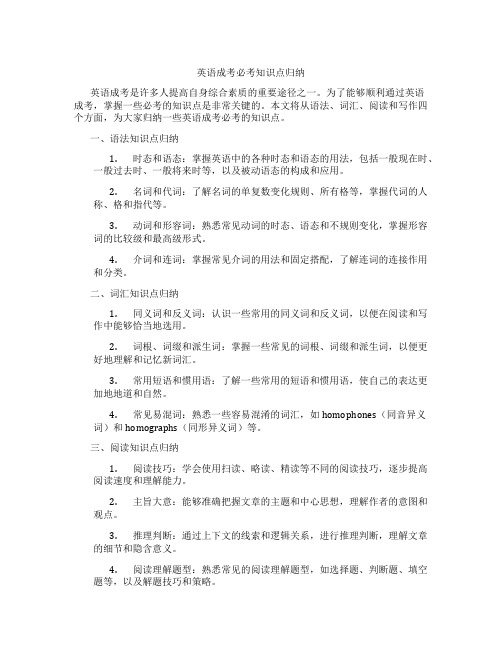
英语成考必考知识点归纳英语成考是许多人提高自身综合素质的重要途径之一。
为了能够顺利通过英语成考,掌握一些必考的知识点是非常关键的。
本文将从语法、词汇、阅读和写作四个方面,为大家归纳一些英语成考必考的知识点。
一、语法知识点归纳1.时态和语态:掌握英语中的各种时态和语态的用法,包括一般现在时、一般过去时、一般将来时等,以及被动语态的构成和应用。
2.名词和代词:了解名词的单复数变化规则、所有格等,掌握代词的人称、格和指代等。
3.动词和形容词:熟悉常见动词的时态、语态和不规则变化,掌握形容词的比较级和最高级形式。
4.介词和连词:掌握常见介词的用法和固定搭配,了解连词的连接作用和分类。
二、词汇知识点归纳1.同义词和反义词:认识一些常用的同义词和反义词,以便在阅读和写作中能够恰当地选用。
2.词根、词缀和派生词:掌握一些常见的词根、词缀和派生词,以便更好地理解和记忆新词汇。
3.常用短语和惯用语:了解一些常用的短语和惯用语,使自己的表达更加地地道和自然。
4.常见易混词:熟悉一些容易混淆的词汇,如homophones(同音异义词)和homographs(同形异义词)等。
三、阅读知识点归纳1.阅读技巧:学会使用扫读、略读、精读等不同的阅读技巧,逐步提高阅读速度和理解能力。
2.主旨大意:能够准确把握文章的主题和中心思想,理解作者的意图和观点。
3.推理判断:通过上下文的线索和逻辑关系,进行推理判断,理解文章的细节和隐含意义。
4.阅读理解题型:熟悉常见的阅读理解题型,如选择题、判断题、填空题等,以及解题技巧和策略。
四、写作知识点归纳1.写作结构:掌握优秀文章的结构,包括引言、主体和结论,以及段落之间的衔接和过渡。
2.语言表达:运用丰富的词汇和恰当的语法结构,使文章的表达更加准确和流畅。
3.逻辑思维:合理组织和展开论述,逻辑清晰,段落之间有层次感和衔接性。
4.修辞手法:巧妙运用一些常见的修辞手法,如比喻、排比、对偶等,使文章更具说服力和感染力。
成人高等教育学士学位英语水平考试复习指导

-___. Let’s discuss it over dinner.
A. That’s all right B. By all means C. Go ahead D. It just depends
1
2
3
4
5
6
易错常考的日常交际用语
---Shall I help you with the suitcase?
01
02
03
04
05
06
会话技能
会话技能
考试中典型的语气词组与含义
2. how come… “… 是怎么回事?为什么?” How come you are late? How come they left you in the dark? 3. why…“为什么要…?干吗要…?”用语肯定句中,后接不带to的不定式。 Why run the risk? Why go there? Why risk breaking the law? 4. what if “(要是)…如何,…怎么样?”后接从句。 What if she finds out that you’ve lost her book? What if we move the picture over there? Do you think it’ll look better?
会话技能
【解析】本题中的对话是在顾客和某单位秘书之间进行的。根据对话中的问题,弄清接电话者的身份很重要。这里是秘书接电话。选项B (Speaking, please.)不对,因为接电话者不是史密斯先生本人。选项A (Hello. Thanks for calling.)自然也不对。接电话的秘书无权一张口就替人表示感谢。选项C (Who’re you, please?)也不对。Who are you, please?是汉语文化方式“请问你是哪一位”的翻版。英语中不能将Please和Who are you一起作为问题句出现。只有选项D ( I’m sorry. He is at a meeting now.)合乎英语的问话习惯。
学位英语知识点复习资料【优秀4篇】
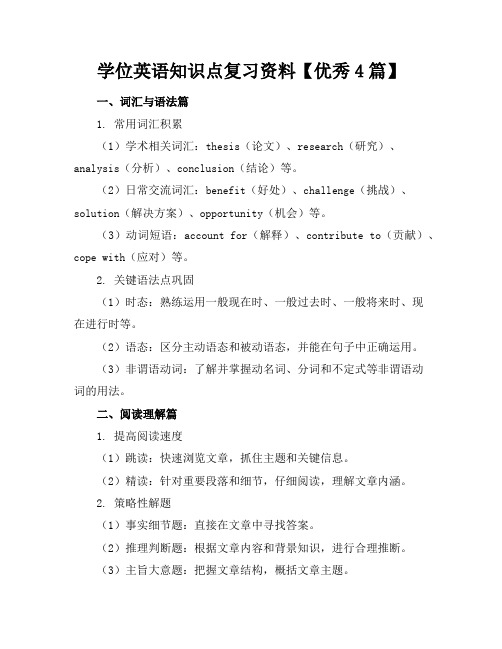
学位英语知识点复习资料【优秀4篇】一、词汇与语法篇1. 常用词汇积累(1)学术相关词汇:thesis(论文)、research(研究)、analysis(分析)、conclusion(结论)等。
(2)日常交流词汇:benefit(好处)、challenge(挑战)、solution(解决方案)、opportunity(机会)等。
(3)动词短语:account for(解释)、contribute to(贡献)、cope with(应对)等。
2. 关键语法点巩固(1)时态:熟练运用一般现在时、一般过去时、一般将来时、现在进行时等。
(2)语态:区分主动语态和被动语态,并能在句子中正确运用。
(3)非谓语动词:了解并掌握动名词、分词和不定式等非谓语动词的用法。
二、阅读理解篇1. 提高阅读速度(1)跳读:快速浏览文章,抓住主题和关键信息。
(2)精读:针对重要段落和细节,仔细阅读,理解文章内涵。
2. 策略性解题(1)事实细节题:直接在文章中寻找答案。
(2)推理判断题:根据文章内容和背景知识,进行合理推断。
(3)主旨大意题:把握文章结构,概括文章主题。
三、完形填空篇1. 培养语感2. 注意上下文联系在解题过程中,关注上下文之间的联系,尤其是代词、转折词等。
四、写作篇1. 提高写作能力(1)积累素材:多阅读优秀文章,学习写作技巧。
(2)模拟练习:针对不同题型,进行模拟练习。
2. 熟悉写作模板学位英语知识点复习资料【优秀4篇】三、听力理解篇1. 提升听力技巧(1)预测能力:在听前根据题目和选项预测对话或短文的内容。
(2)关键词定位:在听的过程中,关注关键词,如数字、专有名词等,以便抓住关键信息。
2. 培养日常听力习惯(1)多听英语广播、新闻、电影等,提高对不同口音和语速的适应能力。
四、翻译篇1. 掌握翻译技巧(1)直译与意译相结合:根据语境灵活运用直译和意译。
(2)词汇准确:确保翻译的词汇准确无误,符合原文含义。
成人学士学位英语考试总复习资料

一、时态和语态?1. 如何解答时态问题例1:You’ve already missed too many classes this term. You ______ just last week.A. missedB. would missC. had missedD. have missed例2:Anne asked Tom ______ the key.A. when he leftB. where he had leftC. how he leftD. why did he left?考试重点:2. 与完成时有关的时态★现在完成时(have done) since, for/ in the past few months, up to now例1:Collecting toy cars as a hobby becomes increasingly popular during the past fifty years.A B C D例2:English ______ in a new way at my college in the past few years.A. has been taughtB. was being taughtC. has been taughtD. had been taught.★过去完成时(had done)例3:Anne asked Tom ______ the key.A. when he leftB. where he had leftC. how he leftD. why did he left例4:The chemistry class_____ for five minutes when we hurried there.A. had been onB. had begunC. has been onD. would began ★将来完成时(will have done) by例5:We’re late I expect the film_____ by the time we get to the cinema.A. had already startedB. have alreadyC. will already have startedD. have already been started.★现在完成进行时(have been doing)例6:It seems oil ___________ from this pipe for some time. We'll have to take the machine apart to put it right.A. had leakedB. is leakingC. leakedD. has been leaking★过去完成进行时(had been doing)★???? 将来完成进行时(will have been doing )例7:By the time you arrive this evening, _______for two hours.A. I will studyB. I will have been studiedC. I had studiedD. I will have been studying.3. 在时间和条件状语从句中不用将来时态▲用一般现在时代替一般将来时例1:When the mixture_____, it will give off a powerful force.A. will heatB. will be heatedC. is heatedD. has heated例2:please be sure to telephone me the next time you ______.A. will comeB. would comeC. shall comeD. come▲用现在完成时代替将来完成时例3:Smith is to study medicine as soon as he_______ military service.A. will finishB. has finishedC. finishD. would finish注意:例4:No one can be sure if the car on display fits him or her until he or she______ them.A. triesB. will tryC. are tryingD. have tried4. 考试小窍门◆考试中如果遇到与完成时态相关的选项,要重点加以研读,一般说来是正确答案。
2024成人高考专升本《英语》考点知识点汇编复习资料(完整版)

第一部分语法知成考专升本英语-考点汇编识第一章名词一、可数名词的复数形式(一)、规则的变复数方法1、一般情况,直接+steacher---teachers ;student---students ;father---fathers ;mother---mothers2、s,x,ch,sh 结尾的单词+esdress---dresses ;box---boxes ;match---matches ;dish---dishes3、以辅音字母+y 结尾的单词:变y 为i,+escity---cities;baby---babies boy---boys*辅音字母判断方法:26个字母中,5个元音:A 、E 、I 、O 、U ,21个辅音:26-5=21个4、以“o”结尾的单词,(1)以"辅音字母+o"结尾的单数名词后+eshero---heroes;mango---mangoes;potato---potatoes;tomato---tomatoes(2)以"元音字母+o"结尾的单数名词后加+szoo---zoos bamboo----bamboos(3)某些外来词,只在词尾+sphoto----photos;piano----pianos5、以f 、f e 结尾的单词,(1)大多数变f 、f e 为“v”+es妻子:wife---wives小刀:knife---knives 狼:wolf---wolves小偷:thief---thieves架子:shelf---shelves自己:self---selves生命:life---lives一半:half---halves叶子:leaf---leaves(2)少部分直接+sroof---roofs屋顶;belief---beliefs信仰;proof---proofs证明;校样*记忆口诀:妻子拿刀去砍狼、小偷吓得发了慌、躲在架后保己命、半片树叶遮目光。
2023成考专升本英语知识点
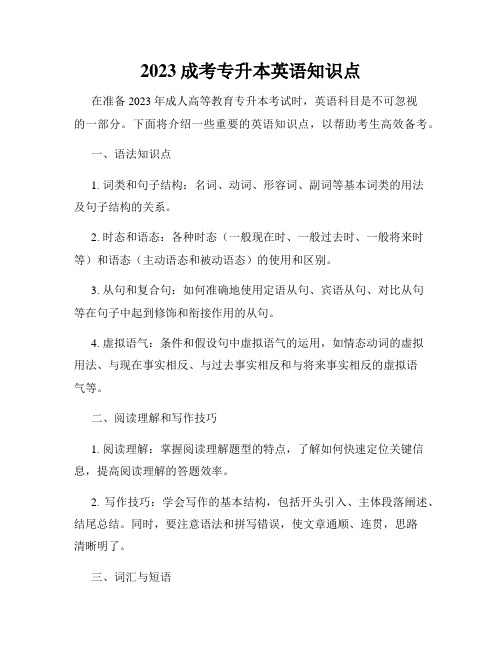
2023成考专升本英语知识点在准备2023年成人高等教育专升本考试时,英语科目是不可忽视的一部分。
下面将介绍一些重要的英语知识点,以帮助考生高效备考。
一、语法知识点1. 词类和句子结构:名词、动词、形容词、副词等基本词类的用法及句子结构的关系。
2. 时态和语态:各种时态(一般现在时、一般过去时、一般将来时等)和语态(主动语态和被动语态)的使用和区别。
3. 从句和复合句:如何准确地使用定语从句、宾语从句、对比从句等在句子中起到修饰和衔接作用的从句。
4. 虚拟语气:条件和假设句中虚拟语气的运用,如情态动词的虚拟用法、与现在事实相反、与过去事实相反和与将来事实相反的虚拟语气等。
二、阅读理解和写作技巧1. 阅读理解:掌握阅读理解题型的特点,了解如何快速定位关键信息,提高阅读理解的答题效率。
2. 写作技巧:学会写作的基本结构,包括开头引入、主体段落阐述、结尾总结。
同时,要注意语法和拼写错误,使文章通顺、连贯,思路清晰明了。
三、词汇与短语1. 同义词和反义词:认识常用的同义词和反义词,了解其在句子中的替换和反义关系。
2. 短语的使用:积累常用的英语短语,包括固定搭配、习惯用语和常用表达方式等。
四、听力技巧1. 监测听力材料:重视平时对英语听力的积累和训练,加强对不同语速、口音和语调的听力理解能力。
2. 笔记技巧:正确记录听力内容的关键信息,如人名、时间、地点等,以帮助回答听力问题。
五、冲刺阶段备考建议1. 模拟考试:完成多套模拟试卷,熟悉考试形式和要求,提高答题速度和准确率。
2. 强化训练:有针对性地进行自我练习和强化训练,特别是对自己薄弱的知识点进行重点巩固。
六、备考注意事项1. 制定学习计划:合理安排每天的学习时间,分配到各个科目和知识点上,以保证全面复习。
2. 坚持积累:每天保持一定时间的英语学习,积累词汇和短语,听力材料和阅读材料,以提升英语水平。
3. 课外拓展:参与英语角、英语研讨会等活动,提高英语口语和交流能力。
成人高等教育学士学位英语考试复习

成人高等教育学士学位英语考试复习资料一、考试题型本考试包括5个部分:阅读理解、词汇和语法、完形填空、英译汉和写作。
客观题目全部按顺序统一编号。
考试时间为120分钟。
第一部分阅读理解(ReadingComprehension),共4篇短文,共20题,占总分的40%。
第二部分词汇和语法(Vocabulary and Structure),共40题,占总分的20%。
第三部分完形填空(Cloze),共20题,占总分的10%。
第四部分英译汉(Translation from English into Chinese),1一2个段落,占总分的15%。
第五部分写作(Writing),占总分的15%。
阅读理解专项练习Passage 1The secret of being born lucky is a summer birthday, with May babies most likely to enjoy a lifetime’s good fortune, according to a study of more than 40,000 people. The time of year at which you are born has an enduring influence on levels of optimism and self-reported luck,according to a research by British and Swedish scientists. May was the luckiest month in which to be born, with 50 percent of those born then considering themselves lucky, while October was the least lucky month, with just 43 percent claiming good fortune.The findings add to growing evidence that the phenomenon of luck is not all down to chance, but is affected by a person’s general disposition. Other research has shown that whether people think themselves fortunate depends less on objective success than on having a “glass half-full” or “half-empty” approach to life. “What we are seeing suggests that something is influencing how people perceive their luckiness. My hypothesis is that people create their own luck by traits such as optimism, that luck is a psychological phenomenon rather than a matter of blind chance,” said Professor Richard Wiseman, who led the research.The pattern of the result, with those born in spring and in summer reporting themselves luckier than those born in autumn or winter, could have two potential explanations, Professor Wiseman said.1.According to the passage, whether people think themselves lucky or notdepends on the following factors EXCEPT _______.A. one’s objective successB. one’s general dispositionC. one’s attitude to lifeD. one’s place of birth2. According to the passage, those who were born in ________ regard themselves as the most fortunate.A. MarchB. AprilC. MayD. October3. Which of the following statements is TRUE according to the passageA. Optimistic people tend to be luckier.B. Devoted people tend to be luckier.C. Objective success is more important than one’s general disposition in feeling lucky.D. People drinking more water tend to be luckier.4. Which of the following words can be best replace the word “trait” (Line 7, Para. 2)A. Quality.B. Expectation.C. Belief.D. Idea5. What is the best title for the passageA. Luck is Something BornB. Luck is Not All Down to ChanceC. Luck is a Matter of Blind ChanceD. Luck and AgePassage 2Man has always wanted to fly. Some of the greatest men in history had thought about the problem. One of them, for example, was the great Italian artist, Leonardo Da Vinci. In the 16th century he made designs for machines that would fly, but they were never built.Throughout history, other less famous men had wanted to fly. An example was a man in England 800 years ago. He made a pair of wings from chicken feathers. Then he fixed them to his body and jumped into air from a tall building. He did not fly very far. Instead, he fell to the ground and broke every bone of his body and rested in peace.The first real step took place in France, in 1783. Two brothers, the Montgolfiers, made a very large “hot air balloon”. They knew that hot air rises. Why not fill a balloon with it The balloon was made of cloth and paper. In September of that year, the King and Queen of France came to see the balloon. They watched it carry the very first air passengers into the sky. The passengers were a sheep and a chicken. We do not know how they felt about the trip. But we do know that the trip lasted eight minutes and that the animals landed safely. Two months later, two men did the same thing. They rose above Paris in a balloon of the same kind. Their trip lasted twenty-five minutes and they traveled about.1. Leonardo Da Vinci _______.A. said that man would fly in the sky one dayB. built a kind of machine which never flewC. made designs for flying machinesD. drew many beautiful pictures of birds2. Eight hundred years ago an Englishman _______.A. made a kind of flying machineB. tried to fly with wings made of chicken feathersC. wanted to build a kind of balloonD. tried to fly on a large bird3. In fact, the Englishman who tried to fly _______.A. got badly woundedB. succeeded in flyingC. lost his lifeD. flew only 8 minutes4. The very first air passengers in the balloon were _______.A. two animalsB. the MontgolfiersC. two FrenchmenD. the King and Queen5. When did two Frenchmen rise above ParisA. In December 1783.B. In September 1783.C. In the 17th century.D. In November 1783.Passage 3Dieting to lose weight has become very popular in recent years. People have become more health conscious and try to take better care of their bodies by eating more nutritiously(有营养的) and exercising more regularly to lose any unnecessary fat that they may have.Not only are people being more careful about what they eat, they are also concerned with how they eat and how their meals are prepared. People are taking more time for each meal. Many avoid the so c alled “plastic” fast-food hamburgers and choose to eat a salad or a sandwich of more healthful ingredients(成分) in a quiet restaurant with a more leisurelyatmosphere. At home, they also try to take enough time to eat a relaxing dinner without phone or TV interruptions.While dieting may be viewed as beneficial, it has also become a serious problem for Americans, particularly for young women. Dieting for them has actually become a psychological addiction(依赖). They eat so little that they can lose as much as fifty percent of their total body weight, and although they look like skeletons, they still insist that they are fat.The current waves of exercising, dieting and the problems produced have caused many organizations to begin educating the public. Many schools, hospitals, health organizations, newspapers and magazines, for example, are offering classes, printing booklet articles, etc. to inform the public of the way to exercise and diet, of the dangers of dieting too rapidly, and of the places people can go for medical help if they find themselves on the road to “diet addiction”.1. These days people are dieting more because _______.A. they have become fatter and fatterB. they have realized the danger of eatingC. they have become more health consciousD. they have taken better care of themselves2. What changes have people made in the atmosphere of mealtimeA. They are taking more time for each meal.B. They are eating in quiet restaurants with more leisurely atmosphere.C. At home they are eating without phone or TV interruptions.D. All of the above.3. “They look like skeletons” in the third paragraph most probably means ________.A. they are very prettyB. they are very uglyC. they are too thinD. they are starving4. The main idea of the last paragraph is about ________.A. how the organizations try to help people with dieting addictionB. what kind of media can be used to educate the publicC. where people with dieting addiction can go to ask for helpD. what causes the organizations to begin educating the public5. According to the passage, we can infer that the atmosphere of eating has something to do with ________.A. dietingB. mannersC. healthD. exercisingPassage 4Do you know who Benjamin Banneker was and what he did Benjamin Banneker was a self-educated scientist at a time when most African Americans wereslaves. Born a free black man in the British Colony of Maryland in 1731, he received some formal education, but he mostly borrowed books and taught himself science and mathematics. At 22, he borrowed a pocket watch, and without any training, figured out how to carve a working wooden clock that chimed each hour. Because of this clock, he became well known and people would visit him just to see his creation.Banneker ran his family farm from many years, but when he was in his late 50s, a neighbor’s son lent him a telescope. He became interested in astronomy, the study of the planets and stars, and again taught himself a new science. He made calculations of tides, sunrises and sunsets, and even predicted an eclipse. For several years he published an almanac of these calculations. Today, he is best known for publishing six almanacs, called “Benjamin Banneker’s Almanac” between 1792 and 1797.In the 1790s, Banneker also helped survey and lay out the land for Washington, D. C., which became the nation’s capital. For a look at Banneker’s amazing life, visit the Benjamin Banneker Historical Park & Museum in Ellicott City, Maryland.1. What was the status of most African-Americans at Banneker’s timeA. Most African-Americans could have formal education.B. Most African-Americans could be self-educated.C. Most African-Americans had freedom.D. Most African-Americans were slaves.2. What subjects did Benjamin teach himselfA. Science and mathematics.B. Science, mathematics and astronomy.C. Astronomy only.D. Six Almanac.3. He became famous at the age of 22 because of ______.A. a watchB. a telescopeC. a bookD. a clock4. The word “almanac” (Line 5, Para. 2) probably means ________.A. a bookB. an objectC. a surveyD. a diary5. Which of Mr. Banneker’s works is best knownA. Eclipse prediction.B. Helping surveying the capital.C. Benjamin Banneker’s Almanac.D. A wooden clock.Passage 5The clock struck eleven at night. The whole house was quiet. Everyone was in bed except me. Under the strong light, I looked sadly before me at a huge pile of that troublesome stuff they call “books”.I was going to have my examina tion the next day. “When can I go to bed” I asked myself. I didn’t answer. In fact, I dare not.The clock struck twelve. “Oh, dear!” I cried. “Ten more books to read before I can go to bed!” We pupils are the most wretched creatures in the world. Dad does not agree with me on this. He did not have to work so hard when he was a boy.The clock stroke one. I was quite desperate now. I forgot all I had learned. I was too tired to go on. I did the only thing I could. I prayed, “Oh, God, please help me pass the e xam tomorrow. I do promise to work hard afterwards, Amen.”My eyes were so heavy that I could hardly open them. A few minutes later, with my head on the desk, I fell asleep.1. When the author was going over his lessons, all the others in the house were _______.A. quietly laughing at himB. outsideC. working in bedD. asleep2. The underlined word “wretched” in Para. 3 probably means ______.A. very happyB. very unhappyC. disappointedD. hopeful.3. Reviewi ng his lessons didn’t help him because _______.A. he hadn’t studied hard before the examinationB. he was very tiredC. his eyes lid were so heavy that he couldn’t keep them openD. it was too late at night4. What do you suppose happed to the authorA. He went to church to pray again.B. He failed in the exam.C. He passed the exam by sheer luck.D. He was punished by his teacher.5. The best title for the passage would be ______.A. A Slow StudentB. Working Far into the NightC. The Night before the ExaminationD. Going over My LessonsPassage 6Today anyone will accept money in exchange for goods and services. People use money to buy food, furniture, books, bicycles and hundreds of others they need or want. When they work, they usually get paid in money.Most of the money today is made of metal pr paper. But people used to use all kinds of things as money. One of the first kinds of money was shells. Shells were not the only things used as money. In China, cloth and knives were used. In the Philippine Islands, rice was used as money. In parts of Africa, cattle were one of the earliest money. Other animals were used as money too.The first metal coins were made in China. They were round and had asquare hole in the center. People strung them together and carried them from place to place. Different countries have used different metals and designs for their money. The first coins in England were made of tin. Sweden and Russia used copper to make their money. Later, other countries began to make coins of gold and silver.But even gold and silver were inconvenient if you had to buy something expensive. Again the Chinese thought of a way to improve money. They began to use paper money. The first paper money looked more like a note from one person to another than paper money used today.Money has had an interesting history from the days of shell money until today.1. Which of the following can be cited as an example of the use of money in exchange for servicesA. To sell a bicycle for $20.B. To get some money for old books at a garage sale.C. To buy things you need or want.D. To get paid for your work.2. Where were shells used as money in historyA. In the Philippines.B. In China.C. In Africa.D. We don’t know.3. Why did ancient Chinese coins have a square hole in the centerA. Because it would be easier to put them together and carry themaround.B. Because it would be lighter for people to carry from place to place.C. Because people wanted to make it look nicer.D. Because people wanted to save the expensive metal they were made from.4. Why does the author say that even gold and silver were inconvenient if you had to buy something expensiveA. Because they are difficult for people to obtain.B. Because they themselves are expensive, too.C. Because they are not easy to carry around.D. Because they are easy to steal.5. Which do you choose as the best title for this passageA. Money and Its UseB. Different Things Used as MoneyC. Different Countries, Different MoneyD. The History of MoneyPassage 7In Denmark, parents are allowed to set up a new school if they are dissatisfied with the school in the area where they are living. Although these schools have to follow the national course, they are allowed a lot of choices in deciding what to teach.Some of these new schools are called “small schools” because usuallythe number of pupils in them is only sixty, but a school has to have at least twenty-seven pupils. Cooleenbridge School in Ireland, is a small school similar to the ones in Denmark, it was set up by parents who came from Holland, Germany, Czechoslovakia, England and other parts of Ireland. They came because they wanted to live in the countryside and to grow their own food. In June 1986, they decided to start a school. They managed to get an old, disused primary school building and started with twenty-four children aged from four to twelve.The teachers say, “The important thing in school is doing, not sitting.” And so the courses include yo ga, cooking, knitting, kite-making, music, fishing, drama and environmental river studies, as well as reading, writing, maths and science.1. What are the rules for setting up a new school in DenmarkA. Parents are allowed to set up their own school.B. The school has to follow the national courses.C. The school has to have at least 27 students.D. All of the above.2. The writer tells about the Cooleenbridge School in the Ireland because ________.A. it was set up by parents who are not people of DenmarkB. it was taken as an example of this kind of “small school”C. there are only twenty-four childrenD. the pupils there were aged from 4 to 123. What makes this kind of school specialA. It is set up by parents not by government.B. It is free to decide what to teach.C. The number of pupils in it is only sixty.D. It has to have at least 27 pupils.4. “The important thing in school is doing, not sitting.” What the teachers say actually means _______.A. what we should do is teaching in the classroom, not sitting in the officeB. children should do more homework at home, not just sit in class to listen to the teachersC. children should learn by themselves not rely on teachersD. children should learn through practice not just from books5. The courses include _________.A. yoga, cooking, knitting, kite-making, music, fishing, drama and environmental river studies, except writing, maths and scienceB. either yoga, cooking, knitting, kite-making, music, fishing, drama and environmental river studies, or reading, writing, maths and scienceC. not only reading, writing, maths and science,but also yoga, cooking, knitting, kite-making, music, fishing, drama and environmental river studiesD. mainly yoga, cooking, knitting, kite-making, music, fishing, drama and environmental river studies, and supplemental (补充的) writing, maths and sciencePassage 8In the United States, 30 percent of the adult population has a weight problem. To many people, the cause is obvious: they eat too much. But scientific evidence does little to support the idea.Going back to the America of the 1910s, we find that people were thinner than today, yet they ate more food. In those days people worked harder physically, walked more, used machines much less and didn’t watch television.Several modern studies, moreover, have shown that fatter people do not eat more on average than thinner people. In fact, some investigations, such as the 1979 study of 3,545 London office workers, report that, on balance, fat people eat less than slimmer people.Studies show that slim people are more active than fat people. A study by a research group at Stanford University School of Medicine found the following interesting facts: The more the men run, the more body fat they lost. The more they ran, the greater amount of food they ate. Thus, those who run the most ate the most, yet lost the greatest amount of body fat.1. The physical problem that many adult Americans have is that ________.A. they are too slimB. they work too hardC. they are too fatD. they lose too much body fat2. According to the article, given 500 adult Americans, ________ will have a weight problem.A. 30B. 50C. 100D. 1503. Is there any scientific evidence to support that eating too much is the cause of a weight problemA. Yes, there is plenty of evidence.B. Of course, there is some evidence to show this is true.C. There is hardly any scientific evidence to support that.D. We don’t know because the information is not given.4. In comparison with the adult American population today, the Americans of the 1910s _______.A. ate more food and had more physical activities.B. ate less food but had more activitiesC. ate less food and had less physical exerciseD. had more weight problems5. Modern scientific researchers have reported to us that ________.A. fat people eat less food and are less activeB. fat people eat more food than slim people and are more activeC. fat people eat more food than slim people but are less activeD. thin people run less, but have greater increase in food intake Passage 9Mass media, the tools of communication, can be divided into two groups: print media and electronic media. By print media, we mean books, newspapers and magazines. Electronic media include television, computer, radio and movie. Mass media allow us to record and pass information rapidly to a large, scattered audience. They extend our ability to talk to each other by helping us overcome barriers cause by time and space.Mass media make daily life easier for us in various ways. Firstly, they help us keep a watch on our world. They gather and pass on information we would be unlikely or unable to obtain on our own.Secondly, mass media help us arrange our time and life. What we talk about and what we think about are greatly influenced by the media. When people get together, they tend to talk about certain happenings in newspapers or on TV. Because we are exposed to different points of view through different kinds of media every day, we are able to evaluate all sides of a certain issue.Thirdly, the media are used to persuade people. Newspapers, magazines and TV are filled with all kinds of colorful, persuasive advertisements. Though many advertisements may not say openly that they want you to buy a certain product, they describe their products in such a way that you may want to buy them.Fourthly, the media also entertain. All media make efforts to entertain their audience. For instance, even though the newspaper is a prime medium of information, it also contains entertainment features. Television, motion picture, some radio stations and magazines are devoted mainly to entertainment. It is estimated that in the future, the entertainment function of mass media will become even more important than it is now.1.What makes it possible for people living in different places tocommunicate with each otherA. Printed media.B. Mass media.C. Electronic media.D. Computers.2. Which of the following functions of mass media is NOT mentionedA. To make people well informed about the world.B. To amuse and entertain people.C. To help people arrange their time and life.D. To give people a sense of honor.3. Certain matters in newspapers or on TV tend to be talked about when people get together because ________.A. people are curious about themB. people are influenced by those mass mediaC. it is fashionable for people to do soD. it is easy for people to communicate in this way4. How does advertisement make people purchase certain goods according to the passageA. By giving an attractive account of the goods.B. By asking people to buy them.C. By forcing people to buy them.D. By giving people something extra.5. Which of the following media is mainly devoted to information according to the passageA. TV.B. Magazine.C. Motion pictures.D. Newspapers.Passage 10Man has always wanted to fly. Some of the greatest men in history had thought about the problem. One of them, for example, was the great Italian artist, Leonardo Da Vinci. In the 16th century he made designs for machines that would fly, but they were never built.Throughout history, other less famous men had wanted to fly. An example was a man in England 800 years ago. He made a pair of wings from chicken feathers. Then he fixed them to his body and jumped into air from a tall building. He did not fly very far. Instead, he fell to the ground and broke every bone of his body and rested in peace.The first real step took place in France, in 1783. Two brothers, the Montgolfiers, made a very large “hot air balloon”. They knew that hotair rises. Why not fill a balloon with it The balloon was made of cloth and paper. In September of that year, the King and Queen of France came to see the balloon. They watched it carry the very first air passengers into the sky. The passengers were a sheep and a chicken. We do not know how they felt about the trip. But we do know that the trip lasted eight minutes and that the animals landed safely. Two months later, two men did the same thing. They rose above Paris in a balloon of the same kind. Their trip lasted twenty-five minutes and they traveled about.1. Leonardo Da Vinci _______.A. said that man would fly in the sky one dayB. built a kind of machine which never flewC. made designs for flying machinesD. drew many beautiful pictures of birds2. Eight hundred years ago an Englishman _______.A. made a kind of flying machineB. tried to fly with wings made of chicken feathersC. wanted to build a kind of balloonD. tried to fly on a large bird3. In fact, the Englishman who tried to fly _______.A. got badly woundedB. succeeded in flyingC. lost his lifeD. flew only 8 minutes4. The very first air passengers in the balloon were _______.A. two animalsB. the MontgolfiersC. two FrenchmenD. the King and Queen5. When did two Frenchmen rise above ParisA. In December 1783.B. In September 1783.C. In the 17th century.D. In November 1783.Passage 11Community service is an important component of education here at our university. We encourage all students to volunteer for at least one community activity before they graduate. A new community program called “One On One” helps elementary students who’ve fallen behind. Your education majors might be especially interested in it because it offers the opportunity to do some teaching, that is, tutoring in Math and English.You’d have to volunteer two hours a week for one semester. You can choose help a child with Math, English, or both. Half-hour lesson are fine, so you could do a half hour of each subject two days a week.Professor Dodge will act as a mentor to the tutors ---- he’ll be available to help you with lesson plans or to offer suggestions for activities. He has office hours every Tuesday and Thursday afternoon. You can sign up for the program with him and begin the tutoring next week.I’m sure you will enjoy this community service and you’ll gain valuable experience at the same time. It looks good on your resume, too,showing that you’ve had experience with children and that you care about your community. If you’d like to sign up, or if you have any questions, stop by Professor Dodge’s office this week.1. What is the purpose of the passageA. To explain a new requirement for graduation.B. To interest students in a new community program.C. To discuss the problems of elementary school students.D. To recruit elementary school teachers for a special program.2. What is the purpose of the program that the passage describesA. To find jobs for graduating students.B. To help education majors prepare for final exams.C. To offer tutorials to elementary school students.D. To provide funding for a community service project.3. What does Professor Dodge doA. He advices students to participate in the special program.B. He teaches part-time in an elementary school.C. He observes elementary school students in the classroom.D. He helps students prepare their resumes.4. What should students interested in the tutorials doA. Contact the elementary school.B. Sign up for a special class.C. Submit a resume to the dean.D. Talk to Professor Dodge.5. Whom do you think the passage dresses toA. Faculty.B. Students.C. Freshman.D. Graduating students of the university. Passage 12Greek soldiers sent messages by turning their shields(盾) toward the sun. The flashes reflected light could be seen several miles away. The enemy did not know what the flashes meant, but other Greek soldiers could understand the message.Roman soldiers in some places built long rows of signal towers. When they had a message to send, the soldiers shouted it from tower to tower. If there were enough towers and soldiers with loud voices, important news could be sent quickly over distance.In Africa, people learn to send messages by beating on a series of large drums. Each drum was kept within hearing distance of the next one. The drum beats were sent out in a special way that all the drummers understood. Though the messages were simple, they could be sent at great speed for hundreds of miles.In the eighteenth century, a French engineer found a new way to send short messages. In this way, a person held a flag in each hand and the arms were moved to various positions representing different letters of the alphabet. It was like spelling out words with flags and arms.。
d成教学士学位英语语法复习重点
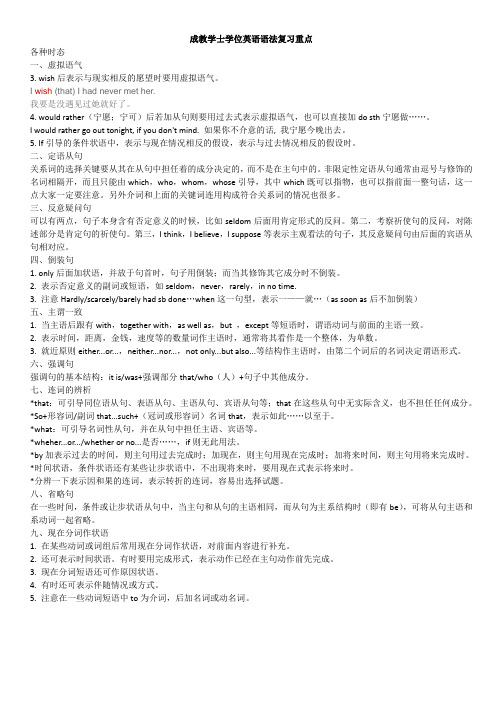
成教学士学位英语语法复习重点各种时态一、虚拟语气3. wish后表示与现实相反的愿望时要用虚拟语气。
I wish (that) I had never met her.我要是没遇见过她就好了。
4. would rather(宁愿;宁可)后若加从句则要用过去式表示虚拟语气,也可以直接加do sth宁愿做……。
I would rather go out tonight, if you don't mind. 如果你不介意的话, 我宁愿今晚出去。
5. If引导的条件状语中,表示与现在情况相反的假设,表示与过去情况相反的假设时。
二、定语从句关系词的选择关键要从其在从句中担任着的成分决定的,而不是在主句中的。
非限定性定语从句通常由逗号与修饰的名词相隔开,而且只能由which,who,whom,whose引导,其中which既可以指物,也可以指前面一整句话,这一点大家一定要注意。
另外介词和上面的关键词连用构成符合关系词的情况也很多。
三、反意疑问句可以有两点,句子本身含有否定意义的时候,比如seldom后面用肯定形式的反问。
第二,考察祈使句的反问,对陈述部分是肯定句的祈使句。
第三,I think,I believe,I suppose等表示主观看法的句子,其反意疑问句由后面的宾语从句相对应。
四、倒装句1. only后面加状语,并放于句首时,句子用倒装;而当其修饰其它成分时不倒装。
2. 表示否定意义的副词或短语,如seldom,never,rarely,in no time.3. 注意Hardly/scarcely/barely had sb done…when这一句型,表示一——就…(as soon as后不加倒装)五、主谓一致1. 当主语后跟有with,together with,as well as,but ,except等短语时,谓语动词与前面的主语一致。
2. 表示时间,距离,金钱,速度等的数量词作主语时,通常将其看作是一个整体,为单数。
- 1、下载文档前请自行甄别文档内容的完整性,平台不提供额外的编辑、内容补充、找答案等附加服务。
- 2、"仅部分预览"的文档,不可在线预览部分如存在完整性等问题,可反馈申请退款(可完整预览的文档不适用该条件!)。
- 3、如文档侵犯您的权益,请联系客服反馈,我们会尽快为您处理(人工客服工作时间:9:00-18:30)。
成人高等教育学士学位英语考试复习要点一、考试题型:词汇与语法、完形填空、阅读、翻译、写作二、语法结构表(Grammar Category)1、名词的复数形式和所有格(1)名词的复数形式名词的规则复数形式,一般在单数形式后面加-s或-es;名词的不规则复数形式不是以词尾加-s或-es构成,其构成方法需要记忆:e.g. foot-feet man-men tooth-teeth woman-women(2)名词的所有格名词的属格表示所属关系,它有两种不同的形式:一是由名词末尾加’s构成(有-s或-es的复数名词末尾只加’);二是由介词of加名词构成。
前者多用来表示有生命的东西;后者多用来表示无生命的东西。
如:e.g. Uncle Tom’s Cabin the two boys’ mother the title of the book·几个词作为一个单位时,’s应加在最后一个词的末尾e.g. the Queen of England’s throne·表示各自的所有关系时,名词末尾均需加’s,如不是这样,仅在最后一词末尾加’s,即表示他们共同的所有关系。
试比较:John and Susan’s desk(约翰和苏珊共用的书桌)John’s and Susan’s desk(约翰和苏珊各自的书桌)·’s属格后的名词如指商店、家宅等地点时,该名词也常省略:e.g. at the doctor’s(在诊所)to my uncle’s(到我叔叔家)2、人称代词/物主代词/反身代词(1)人称代词主格:I, you, he, she, it, we, you, they宾格:me, you, him, her, it, us, you, them(2)物主代词形容词性物主代词:my, your, his, her, its, our, your, their名词性物主代词:mine, yours, his, hers, its, ours, yours, theirs(3)反身代词(指一个动作回射到该动作执行者本身,表强调或加强语气)myself, yourself, himself, herself. Itself, ourselves; yourselves, themselves, oneselfe.g. Please help yourself to some tea.I want to speak to the director himself.3、句子和句子成分Sentence是具有主语部分和谓语部分并有完整意义的可以独立的一组词。
在英语中,sentence的基本结构有下列6种:(1)主语+谓语(SV) e.g. Day dawns.(2)主语+联系动词+表语(SLP) e.g. Tom’s father is a professor.(3)主语+谓语+宾语(SVO) e.g. Ruth understands French.(4)主语+谓语+间接宾语+直接宾语(SVOO) e.g. He told us the whole story.(5)主语+谓语+主语补语(SVC) e.g. He died a poor man.(6)主语+谓语+宾语+宾语补语(SVOC) e.g. He found George intelligent.根据句子的结构,句子可分为:·简单句:含一个主语(或并列主语)和谓语(或并列谓语)的句子。
e.g. She came into the classroom and sat down.·并列句:由等立连词把两个或两个以上的简单句(叫做分句)合成的句子。
e.g. I came home early, but she remained to the end of the concert.·复合句:由一个主句和一个或一个以上从句合成的句子。
e.g. He said he would come in the evening.(各类从句)根据句子的目的或用途来看,句子又可分为:陈述句,疑问句,祈使句,感叹句4、动词的时态(1)一般现在时基本用法:表经常发生的动作或经常存在的状态,常和always, often, usually, sometimes, every day 等表时间的状语连用。
e.g. I go to school every day.My father gets up very early.Note: 一般现在时用于表将来的从句e.g. When I grow up I’ll be a soldier.I’ll wait till he comes.(2)一般过去时基本用法:表示过去某一时间所发生的动作或存在的状态,常和表过去的状语连用,如a minute ago, yesterday, last week, in 1900, during the night, in those days等。
e.g. They got married last year.It happened after three days.(3)一般将来时基本用法:表示单纯的将来事实,常用两个助动词shall, will, 常和表将来的时间状语连用,如tomorrow, next week, next month, next year, in a few days等。
e.g. He’ll come next week.They say that it will be good weather tomorrow.I’ll ask him as soon as he comes.(4)现在完成时动作发生在过去,但对现在有影响(或结果),而这种影响(或结果)却往往是说话人的兴趣所在,所以后面常常不用时间状语。
e.g. The car has arrived.I have lost my pen.Have you ever seen the sea?Notes: 比较have been和have goneI have been to the library. I have gone to the library.·表持续的动作或状态时,常和since, for引导的词语连用。
e.g. I have lived here for more than thirty years.I have been here since last October.(5)过去完成时基本用法与现在完成时相似,通俗地说,是“过去的过去”。
e.g. I had finished my homework before supper.When we got there the basketball match had already started.They had been married many years before a child was born to them.(6)将来完成时表示在将来某一时间之前完成的动作,并往往对将来某一时间产生影响,常和助动词shall, will连用。
e.g. I shall have finished reading the book by the end of this week.If you come at seven o’clock, I shall not yet have finished dinner.(7)现在进行时基本用法:表现在(即说话人的说话时刻,或包括说话时刻在内的一段时间中)正在进行的动作,可与now, at present, at this moment, these days等时间状语连用,也可不用时间状语。
e.g. What are you doing now, John?The telephone is ringing, would you answer it, please?George is translating a book now.Notes: 有些动词的现在进行时则表将来。
e.g. He is dying. Thefruit is ripening. I am finishing.(8)过去进行时基本用法:表过去某一时间(或某一段时间)正在进行的动作,也常和表过去的时间状语连用。
e.g. I was practicing the violin at eight o’clock yesterday evening.When I called him, he was having dinner.They were expecting you yesterday.(表示“一直在等”)(9)将来进行时基本用法:表示在将来某一时间正在进行的动作。
这个时态一般不表意愿,常表已安排好之事,给人一中期待之感。
它一般只表离现在较近的将来,与表将来的时间状语连用。
e.g. What will you be doing this time tomorrow?You’ll be hearing from me.(10)现在完成进行时主要用法:表动作从过去某一时间开始一直延续到现在或离现在不远的时间,下列动词常用于这个时态:live, learn, lie, stay, sit, wait, stand, rest, study等,常和下列时间状语连用:all this time, this week, this month, all night, all the morning, recently, 以及since, for 引导的时间状语短语连用。
e.g. What have you been doing all this time?I’ve been writing letters all this morning.He is ill. He’s been lying in the bed for three weeks.5、主语和谓语的一致(牢记邻近原则)e.g. He or I am in the wrong.He or his brothers were to blame.Either Tim or his brothers have to shovel the snow.Not only the students but also their teacher is enjoying the film. Neither he nor they are mistaken.6、it 的用法(1)it用作引词(anticipatory)·作形式主语,真实主语可为不定式,动名词,主语从句e.g. It was his duty to attend to the matters.It’s no use saying any more about what I think.It seems that he is rich.·作形式宾语,真实宾语可谓不定式,动名词,宾语从句e.g. I find it easy enough to get on with Pam.You must find it exciting working here.I think it best that you should stay here.(2)it用于强调结构结构:It is (was)+被强调部分(主语、宾语或状语)+who(that)……e.g. It was his best suit that John wore to the dance last night.It was my two sisters who knew her best.(保持时态一致)It was yesterday I first noticed it.7、倒装语序(1)完全倒装(complete inversion),即将主语和谓语完全颠倒过来e.g. With the development of typewriter came the most advanced typewriter, the multi-printer, which produces high quality printing.(主语较长而谓语较短)The hammer is missing and so are the nails.(由neither, nor, so引出的句子)From the classroom came the loud voice of the person who was making a speech.(作为地点状语的介词短语置于句首)(2)部分倒装(partial inversion),将助动词(包括情态助动词)移至主语之前e.g. Only on special occasions can you wear this black dress.(句首为only+状语)Not a single clue could the police find.(句首为否定词或带有否定意义的词语:never, rarely, scarcely, hardly, little, not until, no sooner…had, not only…but also, etc.)Do what you will, you can’t change this situation.(某些让步状语从句)Had it not been for the shortage of funds, the hotel could have been built.(省略了if的非真实条件句)8、动词不定式不定式不能在句中单独用作谓语,但可用作主语、表语、宾语、定语、状语、宾语补足语、主语补足语等。
